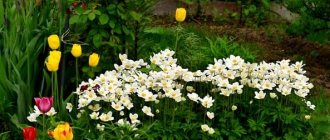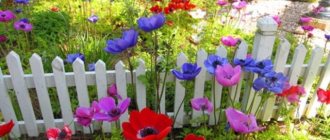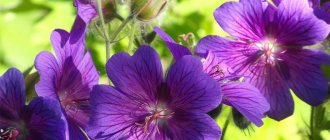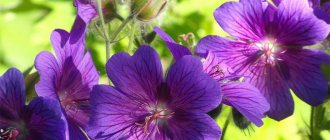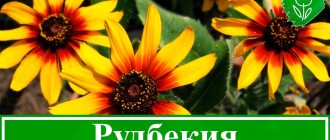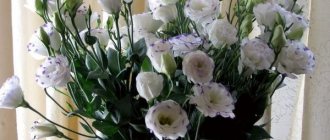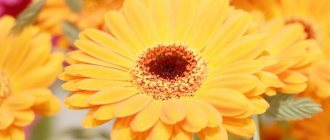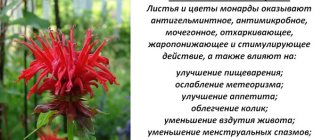The anemone plant, or anemone as it is also called, comes in many different types. In garden plots you can find not only varietal anemones, but also wild ones.
The most popular decorative varieties of anemone among domestic gardeners are tender anemone, crown anemone and Japanese anemone.
Anemone is a perennial flower crop. The name anemone itself translates as “daughter of the winds.”
The flowering of this plant looks like this: the bush is covered with 2-9 umbrellas, consisting of several buds or single inflorescences, as in the photo of anemone flowers. Flowers of the daughter of the winds come in different shades depending on the variety.
Perennial anemone: description and photos of varieties
The anemone petals begin to flutter as soon as a slight breeze blows. Therefore, the flower received names that are in tune with the natural phenomenon.
The daughter of the winds is a herbaceous perennial plant with a thick rhizome. The genus of anemone has about 150 species. They grow throughout the Northern Hemisphere, the Mediterranean, and the temperate zone. You won't meet the daughter of the winds only in the tropics. Moreover, ten species can be seen only beyond the Arctic Circle, and 50 live in Russia and the CIS countries. But most often anemone can be found on a personal plot.
Cultivated plants have:
- The leaf blades are separate or palmately dissected, green, grayish, sometimes silvery.
- There is a rosette at the bottom of the stems, but some perennials do not have one.
- The flowers are solitary or collected in umbels. There are simple, terry, semi-double.
- Small fruits are pubescent or bare in the form of small nuts.
Attractive and bright flowers with delicate leaf blades will decorate any flower bed. Low-growing anemones are placed in the foreground, and tall ones are in the center. Herbaceous perennials thrive under fruit trees. The daughter of the winds is planted along paths and on alpine slides.
Varieties and types with descriptions
There are several classifications of anemone. Many gardeners prefer to use one that takes into account the type of rhizome and the flowering period of the perennial.
Early flowering rhizomatous perennials bloom immediately after the soil thaws. But after flowering has passed, the above-ground part of the plant dries out.
| Name | Stem height in cm | Name in Latin | Flower color |
| Dubravnaya | 20 | Anemone nemorosa | White, pink, cream, lilac. |
| Lutichnaya | 25 | Anemone ranunculoides | The yellow flowers resemble buttercups. |
| Altai | 15 | Anemone altaica | A flower with 8-12 white petals, which have a blue tint on the outside. |
| Smooth | White flowers with large stamens. | ||
| Ural | Anemone Uralensis | Pink | |
| Blue | 20 | Anemone coerulea DC | White, blue |
Tuberous anemones do not bloom for long.
| Name | Stem height | Name in Latin | Flower color |
| crown | 45 | Anemone coronaria | Flowers can be smooth and velvety, combining two colors. |
| Tender | 15 | Anemone blanda Schott & Kotschy | Different |
| Sadovaya | 5 | Different | |
| Caucasian | 10-20 | Anemone caucasica | Blue |
| Apennine | 15 | Anemone apennina | Single blue flowers 3 cm in diameter. |
Anemone caucasica
Anemone blanda Schott
Anemone apennina
Anemone japonica
Anemone hupehensis
Anemone vitifolia
Anemone tomentosa
Anemone hybrida
Anemone sylvestris
Anemone dichotoma
Anemone multifida Rubra
Rhizomatous autumn ornamental plants bloom in late July or early August.
| Name | Stem height | Name in Latin | Flower color |
| Japanese | 80 | Anemone japonica | Pastel shades |
| Khubeiskaya | 150 | Anemone hupehensis | Pink |
| Grape leaf | Anemone vitifolia | White | |
| Felt | 120 | Anemone tomentosa | Pink |
| Hybrid | Anemone hybrida | Different |
For anemones that form root suckers, the growing season lasts the entire summer season.
| Name | Stem height | Name in Latin | Flower color |
| Lesnaya | 20-50 | Anemone sylvestris | Large white flowers up to 5 cm in diameter. |
| Forked | 30-80 | Anemone dichotoma | The petals on the reverse side have a red tint. |
Daughters of the winds, whose homeland is North America, Sakhalin Island, and the Kuril Islands, are rare in the Non-Black Earth Region. But herbaceous perennials look attractive and bloom for a long time.
| Name | Stem height | Name in Latin | Flower color |
| Multifida | Anemone multifida Rubra | Pale yellow, with green stamens. | |
| Canadian | 60 | Anemone canadensis | White |
| Globular | 30 | From light green to purple. | |
| Drumoda | 20 | Anemone drummondii | White on top, green or bluish below. |
| Narcissiflora | 40 | Anemone narcissiflora | Bright yellow or yellow-white. |
| Oregonian | 30 | Different | |
| Richardson | 8-15 | Anemonidium richardsonii | Bright yellow |
Each gardener will be able to choose a cultivated plant to his liking.
general information
The second name of the anemone, better known in our latitudes, is anemone, in fact, an almost literal translation of the scientific name. This is probably because the large, delicate petals are very sensitive to gusts of wind. Large voluminous flowers sway and tremble on thin tall peduncles.
Anemones have long stems and a cylindrical or tuberous root system. It stores nutrients well for vigorous and long-lasting flowering. Large flowers are symmetrical and multi-colored: from white to blue, yellow or red. Scarlet anemones are often confused with wild poppies.
In nature, anemones grow in forests and shady lawns, in mountain valleys, near hills, in meadows and even in the tundra. Some species are used medicinally, while others are used solely for decorative purposes.
Photo: oir.mobi
Features of care
There are many types of anemone; cultivated plants react differently to light and humidity. But there are a number of conditions under which the daughter of the winds feels best:
- the presence of loose, fertilized soil with a small content of river sand;
- absence of strong drafts;
- periodic abundant watering, but so that the water does not stand near the plants;
- loosening at least 2-3 times a month;
- weed removal;
- mulching with dry grass, fallen leaves, rotted sawdust.
Mandatory feeding. The first, as soon as the soil thaws and the plants begin to grow, the second - during the appearance of buds, the third - at the beginning of autumn. They use both traditional fertilizers and special ones for flowers.
Dubravnaya (Anemone nemorosa)
This variety is also called "white" due to the natural color of the petals. Based on the plant, varieties with other colors have been bred: pink, lilac, bluish. The structure of the flower can be either simple or semi-double. The height of the stems is small - only 20–30 cm, and the diameter of the flowers does not exceed 3.5 cm.
Oak anemone blooms in the spring - almost immediately after the snow melts. The flowering period lasts almost a whole month. Already in June, the leaves begin to acquire a yellow tint, and by the height of summer they dry out completely. The variety is propagated by seeds, but due to their poor preservation, dividing the bush is more often used. You can appreciate the modest beauty and features of this anemone from the photo.
Oak anemone has an important advantage - unpretentiousness in the middle climate. The “historical” homeland of the plant is the forests of central Russia, where it can be seen in the spring forest. Therefore, white anemone grows in the garden without difficulty: it is enough to plant it in a shaded corner, because in nature it is located under the canopy of trees. She also loves moisture.
Another feature of the variety is the strong branching of the rhizome. If the growth process is not controlled, then soon the oak grove anemone will fill a vast area in the garden. It is also recommended to pick off old flowers so as not to aggravate the situation by self-sowing.
There are artificially bred varieties:
- 'Alba Plena' - double white flower;
- 'Allenii' is a rare variety with bluish petals tinged with pink;
- 'Robinsoniana' with lilac color.
Reproduction
Depending on the type, herbaceous perennials are planted. A piece of rhizome with buds is separated from the mother plant and planted in a prepared flower garden. The same is done with root shoots. Moreover, this method of propagation is considered the best, because with it the mother bush is minimally injured.
Anemone tubers
The tubers are soaked in a solution of warm water with a growth stimulator, then placed in prepared soil.
The cultivated plant is rarely grown from seeds, since germination may be less than 25%. But some particularly persistent summer residents carry out their plans. In autumn, the seeds are placed in a box with loose soil. It is buried shallowly in the ground on a personal plot. Cover the top with hay, dry branches, and roofing felt. Boards are placed on the structure to prevent the wind from destroying it. In the spring, the box is dug up and the seeds are planted.
Sowing anemones in open ground
Pest and disease control
Anemones are fully adapted to the changeable continental climate and northern cold. They are almost not susceptible to disease if you follow the rules of care. The most common pest is the leaf nematode, which leaves yellow-brown spots on the leaves. Here it is important to remove the affected plants in a timely manner and replace the soil.
Photo: vitusltd.ru
Purslane (80 photos): types, reproduction and care
Choosing a site for planting and preparing the soil
It is important to ensure proper planting and care of the anemone. To do this, you need to perform several steps:
- Dig up the soil after the winter season in order to destroy parasites and larvae that overwintered there.
- Before planting, the soil must be fertilized with organic fertilizers. You can use banana peel infusion or compost.
- Regarding the location, it is better to choose partial shade, because anemones do not like shade, but they also do not feel comfortable in the sun.
- The soil is mixed with sand - this will create ideal soil for anemones.
Japanese (Anemone japonica)
Japanese anemone is a small bush, the height of which does not exceed 40 cm, with dark-colored leaves. The colors of the petals are varied. Flowers are grouped into inflorescences. Anemone japonica was renamed Anemone hupehensis during botanical research, and today its name is Anemone scabiosa.
Anemone flowers in their natural habitat are perennial, but in the middle zone they may not withstand winter frosts. But gardeners love them for their beautiful and abundant flowering, albeit short-lived. Growing the plant requires attention, although it is not particularly difficult. The main thing is to choose a suitable place for it, based on the preferences of each variety.
Tender (Anemone blanda)
The plants are miniature: they rise above the ground by only 5–10 cm. Flowers, similar to daisies, appear in the spring for 2–3 weeks. Grows in both sunny and semi-shaded areas. The colors of the Blanda anemone are varied.
Popular varieties:
- 'Charmer' with dark pink, almost purple petals.
- "Pink Star", or 'Pink Star', is notable for its soft lavender flowers with a pink tint.
- Anemone “Blue Shades” is colored soft blue, which is reflected in the name of the variety: it translates as “blue shadow”. A popular plant with a modest but charming appearance.
- "Radar" is a garden variety with purple petals.
- “Purple Star” has a two-tone color: the white center effectively harmonizes with the main amethyst tone.
Medicinal properties
The anemone flower is used in folk medicine due to its properties:
- has an antifungal effect;
- stops the growth of cancer cells;
- thins the blood, strengthens blood vessels;
- has anti-inflammatory and disinfecting properties.
Infusions are used for cardiovascular diseases, pneumonia, and pathologies of the digestive system. When using anemone-based products, you need to be extremely careful, because it is toxic. It is recommended to consult with specialists in advance to avoid harm to health.
How to grow anemones - reviews from gardeners
For more than 10 years I have been growing tender anemone in the country. It begins to bloom early and after the first frosts it pleases with a beautiful flower bed. For the winter, I do not uproot the tubers, but cover them with agrofibre or leaves. I propagate exclusively by rhizomes. They take root well.
Irina Tishchenko, Moscow
Our winters are not cold, so I don’t pull out the anemone. I have several varieties of Japanese and crown anemone growing. The crown grows a maximum of 20 cm, but blooms well. I water it every day because it rarely rains in summer.
Nadezhda Kovtun, Yeisk
In summing up, it should be noted that the anemone flower has about 170 species, each of which includes many varieties. You can grow anemone in any climate and at any time of the year, the main thing is to choose the appropriate plant.
Hubei (Anemone hupehensis)
The height of the Hubei anemone ranges from 50 to 120 cm. The flowers are not large in size - their diameter is approximately 5-7 cm, but they look very neat and elegant. They decorate the bush for 2 months: August and September.
Popular varieties:
- 'Kriemhilde', grows well in semi-shaded areas. Its flowers are semi-double, colored a rich pink-purple.
- 'Splendens' is a red variety.
- 'September Charm' is a tall plant, bred in England and in good conditions reaching 1.2 m. The color is soft pink, with a slight gradient transition from an almost white edge to a more saturated center.

